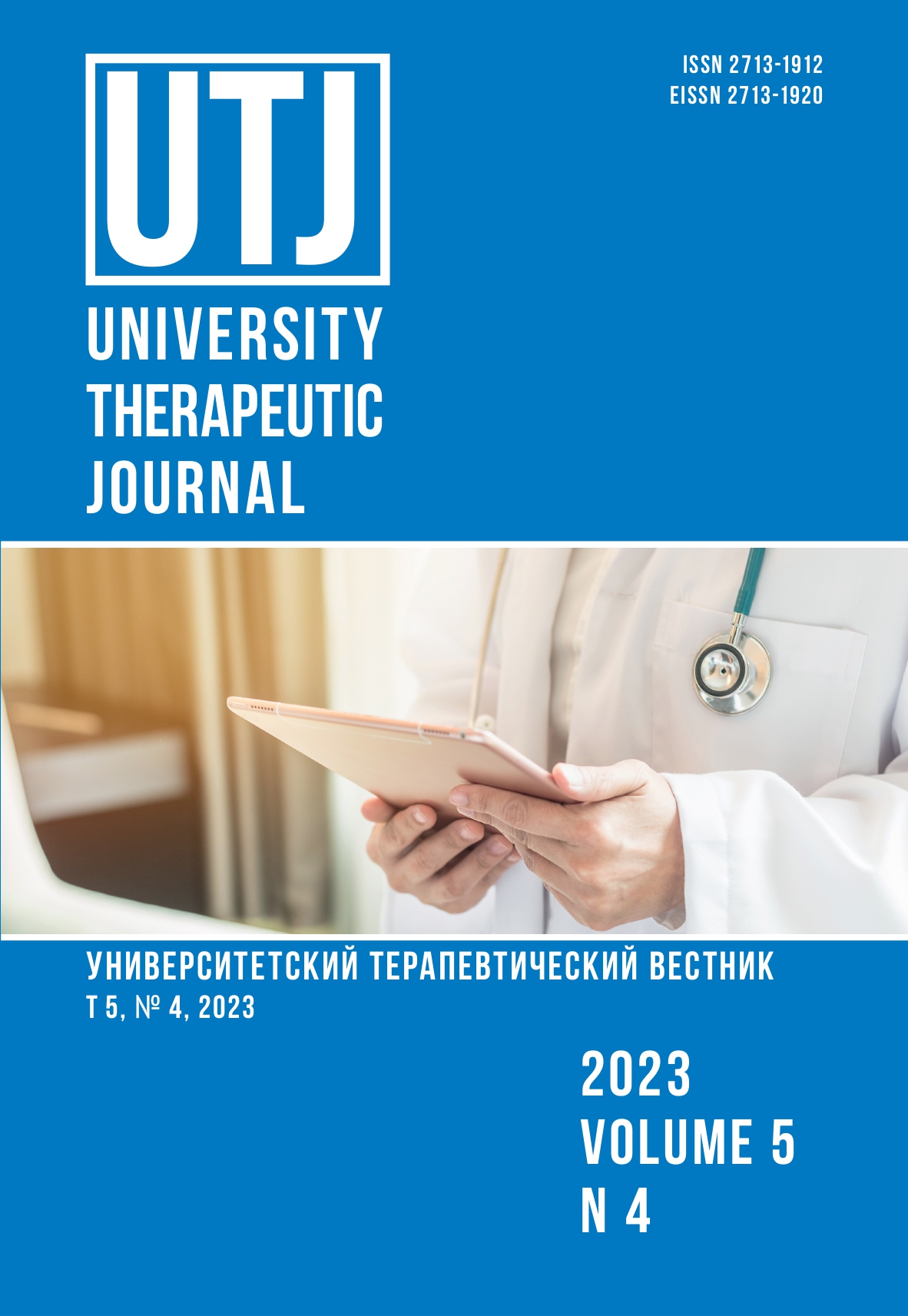FEATURES OF CLINICAL AND ENDOSCOPIC SIGNS OF ULCERATIVE COLITIS
Abstract
Introduction. Ulcerative colitis belongs to the category of immunoinflammatory diseases of the gastrointestinal tract and affects the mucous of the colon with the appearance of erosions and ulcers. The assessment of the course of the disease is carried out on the basis of specific intestinal and extraintestinal complaints of the patient and the endoscopic picture of the colon lesion based on colonoscopy data. At the same time, the invasiveness and complexity of preparation for colonoscopy does not allow it to be performed often, which forces the doctor to determine the tactics of patient management in the absence of endoscopic data, which is especially important in the framework of outpatient observation. The aim of the study was to assess the relationship between the degree of damage to the colon mucous and the clinical manifestations of ulcerative colitis and to develop a method for predicting the depth of damage to the mucous of the colon in ulcerative colitis patients based on a set of specific clinical manifestations of the disease. Materials and methods. A cross-sectional retrospective study was carried out on the basis of the city center for inflammatory bowel diseases of the Elizavetinskaya Hospital. The analysis included data from 106 patients with a verified diagnosis of ulcerative colitis, who underwent colonoscopy and a detailed assessment of ulcerative colitis-specific complaints. Results. The median age of the patients was 37 years, in the study sample the number of men and women was equal. The structure of complaints was dominated by a change in the consistency of the stool in the direction of unformed, mushy and liquid (68 % of patients), abdominal pain/discomfort (63 %), frequent stool (61 %), bloody stool (60 %), while mucus in the stool, fever and false urge to defecate were much less common (36 %, 19 % and 13 %, respectively). According to the results of colonoscopy, mucosal lesions were absent in 28 % of patients; proctitis, left-sided and total colitis occurred in 17, 28 and 26 % of cases, respectively; hyperemia, erosions and ulcers were detected in 7 %, 38 % and 27 % of cases, respectively. As a result of logistic regression analysis, a model was developed for predicting the depth of damage to the colon mucosa based on a set of clinical complaints, the regression formula is: P = 1 / (1 + e–z), where z = –0.734 · [false urges] + 1.397 · [blood in the stool] + 0.397 · [change in the consistency of the stool] + 0.623 × [abdominal pain] + 0.630 · [mucus in the stool] – 0.858. At a value of p ≥ 0.5, the presence of damage to the mucous membrane of the colon in the form of erosions or ulcers is predicted. The sensitivity of the model is 79.7 %, the specificity is 68.8 %. Conclusion. Based on the created logistic regression model, a tool was developed to predict the depth of damage to the mucous of the colon in patients with ulcerative colitis based on the aggregate clinical picture of the disease, in the format of the MS Excel calculator available for download. Diagnostic indicators of the developed model have a value sufficient for the use of this tool in routine clinical practice in outpatient observation of patients with ulcerative colitis.
References
Дементьева Е.А., Степанова А.А., Гурина О.П. и др. Лабораторные показатели аутоагрессии при воспалительных заболеваниях кишечника у детей. Медицина: теория и практика. 2018; 3(3 приложен): 9–12.
Залетова Н.К., Востокова Л.П., Чухловин А.Б. и др. Генетические факторы, влияющие на эффективность терапии глюкокортикоидами при хронических воспалительных заболеваниях кишечника у детей. Педиатр. 2015; 6(3): 91–7. DOI: 10.17816/PED6391-97.
Ивашкин В.Т., Маев И.В., Царьков П.В. и др. Диагностика и лечение язвенной болезни у взрослых. Клинические рекомендации Российской гастроэнтерологической ассоциации, Российского общества колоректальных хирургов и Российского эндоскопического общества. Российский журнал гастроэнтерологии, гепатологии, колопроктологии. 2020; 30(1): 49–70. DOI: 10.22416/1382-4376-2020-30-1-49-70.
Ивашкин В.Т., Шелыгин Ю.А., Белоусова Е.А. и соавт. Проект клинических рекомендаций по диагностике и лечению язвенного колита. Колопроктология. 2019; 18(4): 7–36. DOI: 10.33878/2073-7556-2019-18-4-7-36.
Князев О.В., Болдырева О.Н., Парфенов А.И. и др. Качество жизни больных воспалительными заболеваниями кишечника. Экспериментальная и клиническая гастроэнтерология. 2011; 9: 18–25.
Петров С.В., Успенский Ю.П., Фоминых Ю.А. и др. Клинический случай осложненного течения болезни Крона: трудности диагностики и лечения. Университетский терапевтический вестник. 2022; 4(3): 39–46.
Семионкин Е.И., Трушин С.Н., Куликов Е.П. и др. Осложнения колоноскопии и факторы риска их возникновения (обзор литературы). Колопроктология. 2017; 2(60): 89–93. DOI: 10.33878/2073-7556-2017-0-2-89-93.
Успенский Ю.П., Шабров А.В., Иванов С.В. и др. Базисная терапия воспалительных заболеваний кишечника в Санкт-Петербурге: результаты многоцентрового исследования. Экспериментальная и клиническая гастроэнтерология. 2022; 198(2): 64–76. DOI: 10.31146/1682-8658-ecg-198-2-64-76.
Успенский Ю.П., Иванов С.В., Фоминых Ю.А., Галагудза М.М. Клиническая характеристика воспалительных заболеваний кишечника в Санкт-Петербурге и особенности использования базисной терапии в системе городского здравоохранения: результаты одномоментного эпидемиологического исследования. Экспериментальная и клиническая гастроэнтерология. 2021; 190(6): 29–39. DOI: 10.31146/1682-8658-ecg-190-6-29-39.
Щукина О.Б., Иванов С.В., Шотик А.В. Практические рекомендации для терапевтов по диагностике и лечению язвенного колита. University Therapeutic Journal. 2021; 1: 58–70.
Flynn S. Eisenstein S. Inflammatory Bowel Disease Presentation and Diagnosis. Surg Clin North Am. 2019; 99(6): 1051–62. DOI: 10.1016/j.suc.2019.08.001.
Hodson R. Inflammatory bowel disease. Nature. 2016; 540(7634): S97. DOI: 10.1038/540s97a.
Maaser C., Sturm A., Vavricka S.R. et al. ECCO-
ESGAR Guideline for Diagnostic Assessment in IBD Part 1: Initial diagnosis, monitoring of known IBD, detection of complications. Journal of Crohn’s and Colitis. 2019; 13(2): 144–64K. DOI: 10.1093/ecco-jcc/jjy113.


